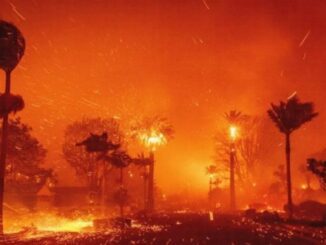
SACRAMENTO, California, August 23, 2020 (ENS) – First came the heatwave, then thousands of lightning strikes, now hundreds of fires.
After more than 10,000 lightning strikes in 72 hours, more than 600 wildfires erupted across California, particularly in the northern part of the state. The fires, which have been exacerbated by a historic heatwave, have burned more than 300,000 acres (1,200 square kilometers) in the state since August 16, 2020. The smoke has spread across vast areas of the western United States and the Pacific Ocean.
The fires in the Bay Area and around Northern California have forced at least 77,000 evacuations and claimed six lives. And the flames have reached through protected groves of some of the oldest and largest trees on Earth – California’s coastal redwoods.

With a long natural lifespan, these redwoods can grow taller than a 30-story building, more than 320 feet, so tall that their crowns are out of sight. Their trunks can grow more than 27 feet wide, about eight paces by an average adult person.
The local conservation organization Save the Redwoods League says these trees can live for more than 2,000 years. “Some coast redwoods living today were alive during the time of the Roman Empire,” the group says.
Despite the fires that burned hundreds of old-growth redwood trees over the past few days, forest and fire ecologist Kristen Shive, director of science at Save the Redwoods League, expressed cautious optimism for the survival of the ancient trees.
“In general,” she said Friday, “coast redwoods are really resilient to fire, with exceptionally thick bark that insulates them from the heat. Even if fire consumes their crowns – lethal for most conifers – the trunk of a redwood can sprout back to life. If this happens, they will look really rough for a while and it will take years for their crowns to fill out again, but the tree will have survived.”
“In cases of extreme heat damage to cambium, the living layer of tissue under the bark, the main trunk might be killed and not even able to sprout, but the tree will likely still sprout from the base. So an ancient giant could die but it will live on in its new shoots. Very extreme heat damage could result in no sprouting at all, but this seems to be pretty uncommon,” she said.
Originally sparked by lightning, the fires are still raging, and the state has closed many of the parks where the redwoods grow to keep the public safe.
In Boulder Creek, the headquarters buildings at Big Basin Redwoods State Park are burned to the ground, but “the vast majority of the park’s famed ancient giant redwoods are still upright,” two journalists from the “Twin Cities Pioneer Press” of St. Paul, Minnesota wrote Thursday.

It took them a five-mile hike through the heart of the Santa Cruz Mountains to reach what’s left of California’s oldest state park after the CZU Lightning Complex wildfire roared through it.
Some redwoods still upright were found burning at the base, the fire-eating up inside their trunks. Shive says the greatest danger to these redwoods now is collapse.
“I suspect the most likely death in the ancient old-growth trees would be from falling over. I am sure you have seen redwoods with past fire damage, where parts of the tree get hollowed out from successive fires over their long lives. Eventually, a fire will come through and the cumulative structural damage can be so great that they topple,” she said.
Due to the widespread fires and extreme weather conditions, California Governor Gavin Newsom, a Democrat, has activated the State Operations Center to its highest level. He declared a statewide emergency on Tuesday, August 18, the first day of the largely virtual Democratic National Convention.
In a quick video recorded for the convention from a forest near Watsonville after his visit to an evacuation center, Newsom called the hundreds of wildfires burning in his state clear evidence of climate change.
“The hots are getting hotter. The dries are getting drier. Climate change is real,” he said. “If you are in denial about climate change, come to California,” Newsom invited.
Beginning on August 14, 2020, an Extreme Heat Event struck California and surrounding Western states, causing record-breaking temperatures and Red Flag Warnings throughout California.

On August 14, Sacramento temperatures hit 106°F, and the thermometer in California’s capital city has soared past 100°F every day this past week. The heatwave peaked on Sunday, August 16 at 112°F – more than 20 degrees higher than the historical average for that date
Despite President Donald Trump’s well-known denials that climate change exists, Newsom said, “California and its federal and local partners are working in lockstep to meet the challenge and remain vigilant in the face of continued dangerous weather conditions.”
And the White House is cooperating. Friday Trump approved California’s request for a Presidential Major Disaster Declaration to bolster the state’s emergency response to the wildfires burning in Northern California and support impacted residents in Lake, Napa, San Mateo, Santa Cruz, Solano, Sonoma and Yolo counties.
“Thank you to the President for your partnership and granting this urgent Major Disaster Declaration. California is battling two of the largest fires in our history and has seen nearly 600 new fires in the last week caused by dry lightning strikes. These are unprecedented times and conditions, but California is strong – we will get through this,” said Governor Newsom.
This presidential declaration helps people in the impacted counties through eligibility for support for crisis counseling, housing and unemployment assistance and legal services. The federal assistance is intended to help state, tribal and local governments fund emergency response, recovery and protective measures.
California also has secured Fire Management Assistance Grants from the Federal Emergency Management Agency to support the state’s response to various fires burning in Santa Clara, Stanislaus, Santa Cruz, San Mateo Napa, Nevada, Lake, Solano, Yolo and Monterey counties.
Residents are under evacuation orders if they live the Eastern Diablo Foothills in Santa Clara, Alameda and Stanislaus Counties. There, the SCU Lightning Complex Wildfire is just 10 percent contained.
The SCU Lightning Complex started on August 16 with at least 20 separate fires in the complex. These 20 fires have merged into three major fires and are broken into three zones; the Canyon Zone, the Calaveras Zone, and the Deer Zone. The fire has continued to burn actively.
The period of main concern on the SCU Lightning Complex will be Sunday evening and overnight into Monday morning. Even if forecast storms miss the complex, gusty outflow winds will be of concern for fire growth and firefighter safety in the next few operational periods.
Fire officials expect an increase in fire activity when the inversion lifts and smoke clears the area. The protection of sensitive wildlife and critical power and communication infrastructure remains a top priority.
On another front, the CZU Lightning Complex fire continues to burn in Southern San Mateo County and Northern Santa Cruz County, from which 77,000 people have been evacuated.
The CZU Lightning Complex fires have burned about 50,000 acres, with zero percent containment as of Friday afternoon, August 21.
Here, the fires have merged and continue to actively burn in the heavy timber and thick undergrowth. Officials say fire activity may dictate more evacuations and road closures in the coming days. Continued hot and dry weather is forecast for next week. Damage Inspection Teams have begun to survey areas where fire activity has diminished and it safe to do so.
Firefighting resources are limited due to the number of fires burning throughout California, and limited visibility due to smoke is hampering aircraft operations
The LNU Lightning Complex is now the second-largest in state history. As of Sunday morning, the fires had consumed 341,243 acres with 17 percent containment, reported the state’s fire management agency Cal Fire.
Located in Napa, Sonoma, Solano, Lake and Yolo counties, the LNU Lightning Complex includes the Hennessey Fire, Aetna Fire, Walbridge Fire, Meyers Fire and Round Fire.
The Walbridge Fire alone, near the towns of Rio Nido and Guerneville, has charred at least 21,125 acres and was zero percent contained as of late Friday.
Many evacuations were lifted in Yolo County on Saturday, but fires continue to make runs in different directions and thunderstorms and lightning in the forecast through Tuesday could bring extreme fire behavior.
The National Weather Service is predicting another round of scattered thunderstorms beginning as early as Sunday afternoon, with a red flag warning lasting through 5 pm Monday.
Dry lightning, possible sparking new fires, and strong winds would pose another huge challenge to firefighters battling the three large complex fires burning hundreds of thousands of acres around the San Francisco Bay Area.
Elsewhere in California, fires are making life miserable just north of Los Angeles. The Lake Fire in the Angeles National Forest near Lake Hughes and the surrounding area has burned 31,089 acres since it started on August 12.
The Lake Fire is moving northwest towards 100-year-old trees: big cone douglas fir, oak and gray pine. Firefighters are facing steep and rugged terrain, high temperatures, critically dry fuels and drought-stressed trees.
The cause of this fire is undetermined, and it is just 53 percent contained. Full containment is not expected until September 2, fire officials say.
Copyright Environment News Service (ENS) 2020. All rights reserved.
© 2020, Environment News Service. All rights reserved. Content may be quoted only with proper attribution and a direct link to the original article. Full reproduction is prohibited.



